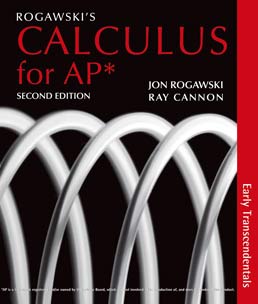
Rogawski's Calculus Early Transcendentals for AP®
Second Edition ©2012 Jon Rogawski; Ray Cannon
Authors
-

Jon Rogawski
Jon Rogawski received his undergraduate and master’s degrees in mathematics simultaneously from Yale University, and he earned his PhD in mathematics from Princeton University, where he studied under Robert Langlands. Before joining the Department of Mathematics at UCLA in 1986, where he was a full professor, he held teaching and visiting positions at the Institute for Advanced Study, the University of Bonn, and the University of Paris at Jussieu and Orsay. Jon’s areas of interest were number theory, automorphic forms, and harmonic analysis on semisimple groups. He published numerous research articles in leading mathematics journals, including the research monograph Automorphic Representations of Unitary Groups in Three Variables (Princeton University Press). He was the recipient of a Sloan Fellowship and an editor of the Pacific Journal of Mathematics and the Transactions of the AMS. As a successful teacher for more than 30 years, Jon Rogawski listened and learned much from his own students. These valuable lessons made an impact on his thinking, his writing, and his shaping of a calculus text. Sadly, Jon Rogawski passed away in September 2011. Jon’s commitment to presenting the beauty of calculus and the important role it plays in students’ understanding of the wider world is the legacy that lives on in each new edition of Calculus.
-

Ray Cannon
Table of Contents
2. Limits
3. Differentiation
4. Applications of the Derivative
5. The Integral
6. Applications of the Integral
7. Techniques of Integration
8. Further Applications of the Integral and Taylor Polynomials
9. Introduction to Differential Equations
10. Infinite Series
11. Parametric Equations, Polar Coordinates, and Vector Functions
12. Differentiation in Several Variables
A. The Language of Mathematics
B. Properties of Real Numbers
C. Induction and the Binomial Theorem
D. Additional Proofs
Answers to the Odd-Numbered Preparing for the AP Exam Questions
References
Photo Credits
Index
Product Updates
Instructor Resources
Instructor Resources
Download Resources
You need to sign in to unlock your resources.
AP Teacher's Resource Binder for Calculus: Early Transcendentals
Lin McMullin | Second Edition | ©2012 | ISBN:9781429286299An invaluable resource for new and experienced teachers alike, the Teacher’s Resource Binder addresses a variety of approaches to the co...
An invaluable resource for new and experienced teachers alike, the Teacher’s Resource Binder addresses a variety of approaches to the course with pacing guides, key points, lecture materials, discussion topics, activities and projects, worksheets, AP style questions, and more. New chapter overviews by Ray Cannon provide a succinct look at each chapter and identify which concepts and topics are most important for students to master in preparation for the AP exam.
Art PowerPoint Slides Sample Chapter 3
Correlation Guide to AP Exam
Errata for Teachers
Printed Test Bank for Calculus: Early Transcendentals for AP
Brian Fulton; Melanie Fulton | Second Edition | ©2012 | ISBN:9781429286275The comprehensive test bank includes thousands of AP-style multiple-choice questions and short answer problems. Modeled on the types of questi...
The comprehensive test bank includes thousands of AP-style multiple-choice questions and short answer problems. Modeled on the types of questions students will see on the AP exam, formats include five distracters and questions based on figures or graphs. All questions may also be found in the ExamView® test bank.
Teacher's Resource Binder Sample Chapter 3
Teacher's Resource CDR for Rogawski Calc AP: Early Trancendentals
Jon Rogawski | Second Edition | ©2012 | ISBN:9781429288842The contents of the Teacher’s Resource Binder, complete solutions, PowerPoint slides, images, and extra material from the book companion...
The contents of the Teacher’s Resource Binder, complete solutions, PowerPoint slides, images, and extra material from the book companion site are all included on this searchable CD.
You've selected:
Click the E-mail Download Link button and we'll send you an e-mail at with links to download your instructor resources. Please note there may be a delay in delivering your e-mail depending on the size of the files.
Warning! These materials are owned by Macmillan Learning or its licensors and are protected by copyright laws in the United States and other jurisdictions. Such materials may include a digital watermark that is linked to your name and email address in your Macmillan Learning account to identify the source of any materials used in an unauthorised way and prevent online piracy. These materials are being provided solely for instructional use by instructors who have adopted Macmillan Learning’s accompanying textbooks or online products for use by students in their courses. These materials may not be copied, distributed, sold, shared, posted online, or used, in print or electronic format, except in the limited circumstances set forth in the Macmillan Learning Terms of Use and any other reproduction or distribution is illegal. These materials may not be made publicly available under any circumstances. All other rights reserved. For more information about the use of your personal data including for the purposes of anti-piracy enforcement, please refer to Macmillan Learning's.Privacy Notice
Thank you!
Your download request has been received and your download link will be sent to .
Please note you could wait up to 30 to 60 minutes to receive your download e-mail depending on the number and size of the files. We appreciate your patience while we process your request.
Check your inbox, trash, and spam folders for an e-mail from InstructorResources@macmillan.com.
If you do not receive your e-mail, please visit macmillanlearning.com/support.
Authors
-

Jon Rogawski
Jon Rogawski received his undergraduate and master’s degrees in mathematics simultaneously from Yale University, and he earned his PhD in mathematics from Princeton University, where he studied under Robert Langlands. Before joining the Department of Mathematics at UCLA in 1986, where he was a full professor, he held teaching and visiting positions at the Institute for Advanced Study, the University of Bonn, and the University of Paris at Jussieu and Orsay. Jon’s areas of interest were number theory, automorphic forms, and harmonic analysis on semisimple groups. He published numerous research articles in leading mathematics journals, including the research monograph Automorphic Representations of Unitary Groups in Three Variables (Princeton University Press). He was the recipient of a Sloan Fellowship and an editor of the Pacific Journal of Mathematics and the Transactions of the AMS. As a successful teacher for more than 30 years, Jon Rogawski listened and learned much from his own students. These valuable lessons made an impact on his thinking, his writing, and his shaping of a calculus text. Sadly, Jon Rogawski passed away in September 2011. Jon’s commitment to presenting the beauty of calculus and the important role it plays in students’ understanding of the wider world is the legacy that lives on in each new edition of Calculus.
-

Ray Cannon
Table of Contents
2. Limits
3. Differentiation
4. Applications of the Derivative
5. The Integral
6. Applications of the Integral
7. Techniques of Integration
8. Further Applications of the Integral and Taylor Polynomials
9. Introduction to Differential Equations
10. Infinite Series
11. Parametric Equations, Polar Coordinates, and Vector Functions
12. Differentiation in Several Variables
A. The Language of Mathematics
B. Properties of Real Numbers
C. Induction and the Binomial Theorem
D. Additional Proofs
Answers to the Odd-Numbered Preparing for the AP Exam Questions
References
Photo Credits
Index
Product Updates
FAQs
-
-
Are you a campus bookstore looking for ordering information?
MPS Order Search Tool (MOST) is a web-based purchase order tracking program that allows customers to view and track their purchases. No registration or special codes needed! Just enter your BILL-TO ACCT # and your ZIP CODE to track orders.
Canadian Stores: Please use only the first five digits/letters in your zip code on MOST.
Visit MOST, our online ordering system for booksellers: https://tracking.mpsvirginia.com/Login.aspx
Learn more about our Bookstore programs here: https://www.macmillanlearning.com/college/us/contact-us/booksellers
-
-
-
Our courses currently integrate with Canvas, Blackboard (Learn and Ultra), Brightspace, D2L, and Moodle. Click on the support documentation below to find out more details about the integration with each LMS.
Integrate Macmillan courses with Blackboard
Integrate Macmillan courses with Canvas
-
-
-
If you’re a verified instructor, you can request a free sample of our courseware, e-book, or print textbook to consider for use in your courses. Only registered and verified instructors can receive free print and digital samples, and they should not be sold to bookstores or book resellers. If you don't yet have an existing account with Macmillan Learning, it can take up to two business days to verify your status as an instructor. You can request a free sample from the right side of this product page by clicking on the "Request Instructor Sample" button or by contacting your rep. Learn more.
-
-
-
Sometimes also referred to as a spiral-bound or binder-ready textbook, loose-leaf textbooks are available to purchase. This three-hole punched, unbound version of the book costs less than a hardcover or paperback book.
-
-
-
We can help! Contact your representative to discuss your specific needs for your course. If our off-the-shelf course materials don’t quite hit the mark, we also offer custom solutions made to fit your needs.
-
FAQs
-
-
Are you a campus bookstore looking for ordering information?
MPS Order Search Tool (MOST) is a web-based purchase order tracking program that allows customers to view and track their purchases. No registration or special codes needed! Just enter your BILL-TO ACCT # and your ZIP CODE to track orders.
Canadian Stores: Please use only the first five digits/letters in your zip code on MOST.
Visit MOST, our online ordering system for booksellers: https://tracking.mpsvirginia.com/Login.aspx
Learn more about our Bookstore programs here: https://www.macmillanlearning.com/college/us/contact-us/booksellers
-
-
-
Our courses currently integrate with Canvas, Blackboard (Learn and Ultra), Brightspace, D2L, and Moodle. Click on the support documentation below to find out more details about the integration with each LMS.
Integrate Macmillan courses with Blackboard
Integrate Macmillan courses with Canvas
-
-
-
If you’re a verified instructor, you can request a free sample of our courseware, e-book, or print textbook to consider for use in your courses. Only registered and verified instructors can receive free print and digital samples, and they should not be sold to bookstores or book resellers. If you don't yet have an existing account with Macmillan Learning, it can take up to two business days to verify your status as an instructor. You can request a free sample from the right side of this product page by clicking on the "Request Instructor Sample" button or by contacting your rep. Learn more.
-
-
-
Sometimes also referred to as a spiral-bound or binder-ready textbook, loose-leaf textbooks are available to purchase. This three-hole punched, unbound version of the book costs less than a hardcover or paperback book.
-
-
-
We can help! Contact your representative to discuss your specific needs for your course. If our off-the-shelf course materials don’t quite hit the mark, we also offer custom solutions made to fit your needs.
-
Rogawski's Calculus Early Transcendentals for AP®
Select a demo to view:
These materials are owned by Macmillan Learning or its licensors and are protected by United States copyright law. They are being provided solely for evaluation purposes only by instructors who are considering adopting Macmillan Learning's textbooks or online products for use by students in their courses. These materials may not be copied, distributed, sold, shared, posted online, or used, in print or electronic format, except in the limited circumstances set forth in the Macmillan Learning Terms of Use and any other reproduction or distribution is illegal. These materials may not be made publicly available under any circumstances. All other rights reserved. © 2020 Macmillan Learning.
BY CLICKING ON THE SAMPLE CHAPTER LINK BELOW, YOU ARE AGREEING TO USE THESE MATERIALS ONLY IN ACCORDANCE WITH MACMILLAN LEARNING'S TERMS OF USE.
Select a file to view:





